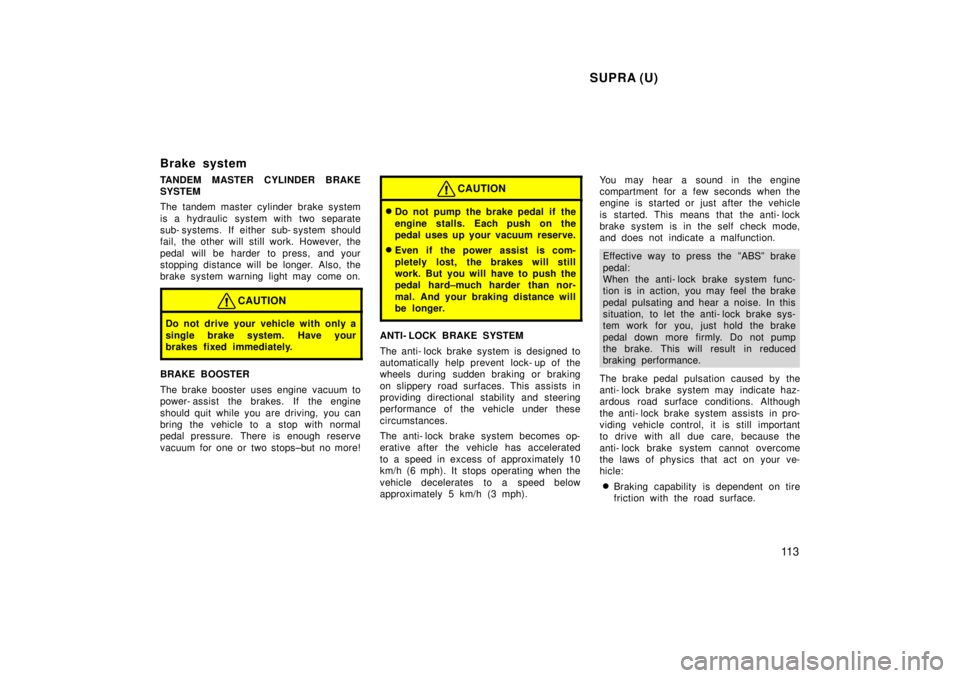Page 104 of 191

SUPRA (U)
104
Leave the system on during ordinary
driving so that it can operate when
needed. When traction control is ap-
plied, the slip indicator light blinks. If
your vehicle still skids even though
traction control is applied, more power-
ful traction control is applied and the
ºSNOWº indicator light comes on.
You may hear a slight clicking noise in
the engine compartment when the engine
is started. This means that the traction
control system is in the self- check mode,
and does not indicate malfunction. When
the traction control system is operating,
you may feel vibration of your vehicle,
caused by operation of the brakes. This
indicates the system is functioning proper-
ly.
When getting the vehicle out of mud or
new snow, etc. the traction control system
will help operate to prevent the wheels
from spinning.
MANUAL SNOW OPERATION
You can select the snow mode by push-
ing the ºSNOWº switch. The ºSNOWº
indicator light will come on.
To select the automatic mode, push the
ºOFFº switch. The ºSNOWº indicator
light will go off. If your vehicle still
skids, the system automatically oper-
ates.
MANUAL TRACTION CONTROL OFF OP-
ERATION
You can turn off the traction control
system by pushing the ºOFFº switch.
The ºTRAC OFFº indicator/warning light
will come on. Pushing the ºOFFº switch
a second time turns on the traction
control system and the ºTRAC OFFº
indicator/warning light will go off.
If the ºSNOWº indicator light is on,
pushing the ºOFFº switch once selects
the outomatic mode and pushing it a
second time turns off the traction con-
trol system.
Page 113 of 191

SUPRA (U)11 3
Brake system
TANDEM MASTER CYLINDER BRAKE SYSTEM
The tandem master cylinder brake system
is a hydraulic system with two separate
sub- systems. If either sub- system s
hould
fail, the other will still work. However, the
pedal will be harder to press, and your
stopping distance will be longer. Also, the
brake system warning light may come on.
CAUTION
Do not drive your vehicle with only a
single brake system. Have your
brakes fixed immediately.
BRAKE BOOSTER
The brake booster uses engine vacuum to
power- assist the brakes. If the engine
should quit while you are driving, you can
bring the vehicle to a stop with normal
pedal pressure. There is enough reserve
vacuum for one or two stops±but no more!
CAUTION
� Do not pump the brake pedal if the
engine stalls. Each push on the
pedal uses up your vacuum reserve.
� Even if the power assist is com-
pletely lost, the brakes will still
work. But you will have to push the
pedal hard±much harder than nor-
mal. And your braking distance will
be longer.
ANTI- LOCK BRAKE SYSTEM
The anti- lock brake system is designed to
automatically help prevent lock- up of the
wheels during sudden braking or braking
on slippery road surfaces. This assists in
providing directional stab ility and steering
performance of the vehicle under these
circumstances.
The anti- lock brake system becomes op-
erative after the vehicle has accelerated
to a speed in excess of approximately 10
km/h (6 mph). It stops operating when the
vehicle decelerates to a speed below
approximately 5 km/h (3 mph). You may hear a sound in the engine
compartment for a few seconds when the
engine is started or just after the vehicle
is started. This means that the anti- lock
brake system is in the self check mode,
and does not indicate a malfunction.
Effective way to press the ºABSº brake
pedal:
When the anti- lock brake system func-
tion is in action, you may feel the brake
pedal pulsating and hear a noise. In this
situation, to let the anti- lock brake sys-
tem work for you, just hold the brake
pedal down more firmly. Do not pump
the brake. This will result in reduced
braking performance.
The brake pedal pulsation caused by the
anti- lock brake system may indicate haz-
ardous road surface conditions. Although
the anti- lock brake system assists in pro-
viding vehicle control, it is still important
to drive with all due care, because the
anti- lock brake system cannot overcome
the laws of physics that act on your ve-
hicle: � Braking capab ility is dependent on tire
friction with the road surface.
Page 123 of 191

SUPRA (U)123
Trailer towing
Toyota does not recommend towing a trail-
er with your Supra. It is not designed for
trailer towing.
Getting more kilometers/mileage from a
liter/gallon of fuel is easyÐjust take it
easy. It will help make your vehicle last
longer, too. Here are some specific tips
on how to save money on both fuel and
repairs:
� Keep your tires inflated at the cor-
rect pressure. Underinflation causes
tire wear and wastes fuel. See Chapter
7- 2 for instructions.
� Do not carry unneeded weight in
your vehicle. Excess weight puts a
heavier load on the engine, causing
greater fuel consumption.
� Avoid lengthy warm- up idling. Once
the engine is running smoothly, begin
drivingÐbut gently. Remember, howev-
er, that on cold winter days this may
take a little longer.
� Accelerate slowly and smoothly.
Avoid jackrabbit starts. Get into high
gear as quickly as possible.
� Avoid long engine idling. If you have
a long wait and you are not in traffic,
it is better to turn off the engine and
start again later.
� Avoid engine lug or overrevving. Use
a gear position suitable for the road on
which you are travelling. �
Avoid continuous speeding up and
slowing down. Stop- and- go driving
wastes fuel.
� Avoid unnecessary stopping and
braking. Maintain a steady pace. Try
to time the traffic signals so you only
need to stop as little as possible or
take advantage of through streets to
avoid traffic lights. Keep a proper dis-
tance from other vehicles to avoid sud-
den braking. This will also reduce wear
on your brakes.
� Avoid heavy traffic or traffic jams
whenever possible.
� Do not rest your foot on the clutch
or brake pedal. This causes needless
wear, overheating and poor fuel econo-
my.
� Maintain a moderate speed on high-ways. The faster you drive, the greater
the fuel consumption. By reducing your
speed, you will cut down on fuel con-
sumption.
� Keep the front wheels in proper
alignment. Avoid hitting the curb and
slow down on rough roads. Improper
alignment not only causes faster tire
wear but also puts an extra load on
the engine, which, in turn, wastes fuel.
How to save fuel and make
your vehicle last longer, too